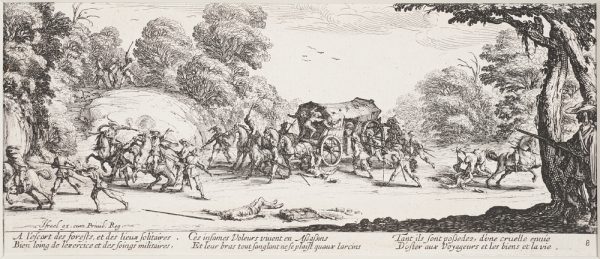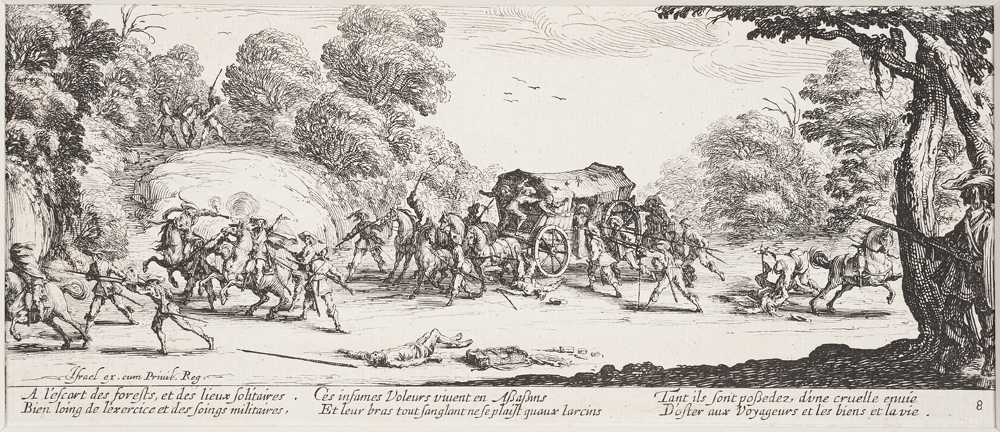
Attack on a Coach
Callot, Jacques
1633
Artwork Information
-
Title:
Attack on a Coach
-
Artist:
Callot, Jacques
-
Artist Bio:
French, 1592–1635
-
Date:
1633
-
Medium:
Etching
-
Dimensions:
3 x 7 3/8 inches
-
Credit Line:
Wichita Art Museum, L. S. and Ida L. Naftzger Collection of Prints
-
Object Number:
1943.36
-
Display:
Not Currently on Display
About the Artwork
The French 17th-century printmaker Jacques Callot was a major progenitor of the art of etching and his late work, a series of eighteen plates titled The Large Miseries and Misfortunes of War, ranks as a masterpiece of both craft and content.[i] These images display the effects of all of the technical innovations introduced and perfected by Callot including the invention of hard ground etching, the invention of the échoppe etching tool with a versatile oval end, and the practice of multiple stopping out and biting of lines to achieve a great variation of tone in one plate. Each of these technical innovations heightened Callot’s achievement of the fluid arabesque line, dramatic contrasts of dark and light, and atmospheric projections of depth that satisfied his rococo aesthetic.
During his service to princely patrons Jacques Callot depicted a number of famous battles and military events. The narrative of The Miseries of War was however the artist’s own invention and it was a presentation of ground-breaking realism. The events of troops out of control, severe punishments, neglect of veterans, and peasant revolts actually happened but had not been depicted.[ii] Callot relied upon his own historic research and that of other sixteenth-seventeenth century artistic depictions of war to give accurate account of military weaponry, dress, and camp life. Being an accomplished master of realistic Dutch genre and landscape traditions, he was equally well equipped to render details of contemporary town and domestic life as well as architecture and countryside. Scholars now generally agree that Callot addressed what was a major philosophic concern of the period, how to remedy the excessive sufferings of citizens and soldiers, and, believing war to be a fact of life, how to conduct a just war.[iii] The final plate depicting the Distribution of Rewards is a subject introduced by Callot and emphasizes the wisdom of just rewards as well as just punishments.
The viewer’s experience of Callot’s Miseries of War is in many ways as intimate and intense a process as that of reading a book. Because the images are so small and teeming with activity one must get physically close to them and spend some time exploring each scene. In the panorama of Plundering a Large Farmhouse, the design of unfolding and overlapping vignettes leads the viewer skillfully across the page and, following the dramatic shifts in light and shadow, weaves attention smoothly from foreground to background. Within this unifying atmospheric pattern, the artist reveals a wealth of incidental information about the storage of foodstuffs and cookware, the design of sleeping quarters and the placement of fireplaces, all the while confronting the viewer with a catalogue of ever more shocking horrors from the slaughter of animals, looting, vandalism, rape, and murder, to the most hideous roasting of human bodies over the great kitchen hearth. However, emotional engagement remains at the safe distance of theater or spectacle while the viewer’s scientific sense is carefully directed from the evidence of factual detail to a concluding argument for remedial action.
The children of Wichitans L.S. and Ida L. Naftzger presented a significant collection of old master prints, including this particularly fine proof of Callot’s Large Miseries of War, to the Wichita Art Museum in memory of their parents. The collection, assembled by William H. Lautz, husband of Pauline Naftzger Lautz, was also intended to provide the museum’s Midwestern audience with access to examples of the European foundation of Western printmaking.
[i] The word large has subsequently been inserted into the title by collectors and historians to distinguish this series from the series of the same name by Callot that immediately preceded this one. The earlier series is called by scholars The Small Miseries and Misfortunes of War the earlier plates are of smaller scale and the series numbers only six plates.
[ii] H. Diane Russell, “The Military,” Jacques Callot Prints & Related Drawing (National Gallery of Art: Washington, D. C., 1975), p. 209, referencing the research of George Clark, War and Society in the Seventeenth Century, Cambridge, 1958.
[iii] Diane Wolfthal, “Jacques Callot’s Miseries of War,” The Art Bulletin, June 1977, Vol. LIX, No. 2, pp. 222-233, first asserted this thesis, now generally adopted, in a seminar report presented at the Institute of Fine Arts, New York University in the spring of 1975.
